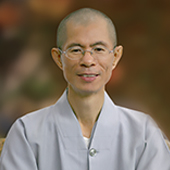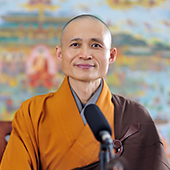Keeping Amitabha’s Primal Vow Close to Our Hearts
In the teachings of the Visualization Sutra, Shakyamuni Buddha’s heart was deeply connected to the primal vow of Amitabha (also known as Amituofo in Chinese). Amituofo’s primal vow permeated the entire sutra from beginning to end. However, one may wonder, where is the evidence of this?
Consider the story of Lady Vaidehi who was imprisoned within the palace and who yearned for the comforting presence of Ananda. Unexpectedly, it was Shakyamuni Buddha himself, the World Honored One, who arrived unbidden, making the journey from Vulture Peak. Why did he come? It was because he held Amituofo’s primal vow close to his heart. This incident serves as the first indication of the deep connection between Shakyamuni Buddha and Amituofo.
When Lady Vaidehi expressed her desire to be reborn in a land of no sorrow and no affliction, the World Honored One emitted a flood of light from between his eyeb-rows. Returning to the Buddha, the light settled on his head and transformed itself into a golden platform. On the platform appeared the pure lands of all the Buddhas in the ten directions. The light guided Lady Vaidehi in selecting Amituofo’s Land of Ultimate Bliss. Shakyamuni Buddha performed this act because he kept Amituofo's primal vow very close to his heart. Although all Buddha lands in the ten directions are pure and without defilements, attaining rebirth in those lands is not easily accomplished since those Buddhas have not made the specific forty-eight vows, as Amituofo has, to liberate ordinary beings from samsara simply by reciting the Buddha’s name. Therefore, Shakyamuni Buddha utilized his supernatural powers to conceal the superior qualities of those other lands, while highlighting the supreme adornments of the Western Pure Land. As Master Shandao eloquently proclaimed, “While the Buddhas’ lands in the ten directions are all extraordinary, they cannot compare to the supreme adornments and pristine state of the Land of Ultimate Bliss.” He further stated, “One should recognize that each of the forty-eight vows made by Amituofo is a strong transformative cause." This serves as the second indication of their profound connection.
When Lady Vaidehi expressed her aspiration for rebirth in Amituofo’s Land of Ultimate Bliss, Shakyamuni Buddha smiled and from his mouth came colored rays of light. This reaction reflected his resonance with Amituofo’s primal vow. Master Shandao interpreted the Buddha’s reaction in the following way. “The Tathagata was delighted to witness Lady Vaidehi’s aspiration for rebirth in the Land of Bliss and her pursuit of the path towards it. Lady Vaidehi's action aligns with the Tatgagati’s intention, and with the purpose of Amituofo’s vows.” This is the third indication of the profound connection.
Each of the Thirteen Meditative Visualizations is deeply rooted in the primal vow. For example, during the Seventh Visualization, just as the World Honored One was about to expound the Dharma to eliminate suffering, Amituofo immediately appeared in response. This is because in Shakyamuni Buddha’s mind, the “Dharma to eliminate suffering” is synonymous with Amituofo's primal vow. As Master Shandao put it, “Shakyamuni Buddha, in order to save sentient beings, teaches us to aspire to go to the Land of Bliss in the West; the compassionate Amituofo in that land, being aware of Shakyamuni's teaching, responds by manifesting in the Saha World in the East.” This demonstrates that the hearts of the two Buddhas mirror each other for the purpose of delivering all sentient beings. What Shakyamuni Buddha has in mind is Amituofo's primal vow. This is the fourth indication.
Now let us examine the Ninth Visualization, which reads: “Amituofo’s light permeates all worlds, always embracing those who recite his name.” Embracing those who recite the Buddha’s name is the objective of the primal vow. Master Shandao explains, "Only those who recite Amituofo's name are embraced by his light, the Buddha’s primal vow is the most powerful." Why does Amituofo’s light embrace only those who recite his name? It is because the practice of nianfo (Amitabha-recitation) resonates with Amituofo’s primal vow, which the Buddha pledged in his casual land. The resultant infinite light in the Land of Bliss is the effect of that vow. The law of cause and effect is perfectly aligned. Shakyamuni Buddha teaches the Ninth Visualization of the Dharma Body precisely because he has Amituofo’s fundamental vow in mind. This serves as the fifth proof.
The Visualization of the Dharma Body, being the core of the Thirteen Visualizations, is intrinsically linked to the Buddha’s Primal Vow. Consequently, all thirteen visualizations can be considered as being rooted in that Vow accordingly. This is the sixth item of proof.
Moreover, all beings of the Nine Grades for rebirth, even though they are mere ordinary beings, are able to be reborn in Amituofo’s reward land of Ultimate Bliss. This is made possible by their reliance on the powerful force of the Buddha’s vow. Once again, Shakyamuni Buddha teaches us about the rebirth of the nine grades because he understands Amituofo’s fundamental vow. This serves as the seventh indication.
Among the nine grades, individuals in the lowest three tiers are considered the most afflicted, as they have committed the ten transgressions and the five evil deeds, and violated the precepts. However, despite their past serious wrongdoings, they have the opportunity to reach the Land of Bliss by simply reciting the name of Amituofo, even just ten times or once. This remarkable outcome illustrates the immense power of Amituofo’s primal vow, which aims to deliver all those who recite his name. This serves as the eighth proof within the Visualization Sutra.
While covering a wide range of subjects in the Visualization Sutra, the teachings of Shakyamuni Buddha consistently revolve around a single theme - keeping Amituofo’s Fundamental Vow in mind. His purpose is to direct our attention towards a specific goal, which is embracing the Buddha’s Fundamental Vow within our hearts.
(Excerpt from “Master Shandao’s Thoughts on the Pure Land Dharma Path.”)
(Translated by the Pure Land School Translation Team;
edited by Householder Fojin)
Guiding Principles
Faith in, and acceptance of, Amitabha’s deliverance
Single-minded recitation of Amitabha’s name
Aspiration to rebirth in Amitabha’s Pure Land
Comprehensive deliverance of all sentient beings


